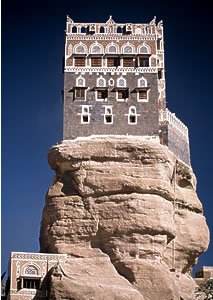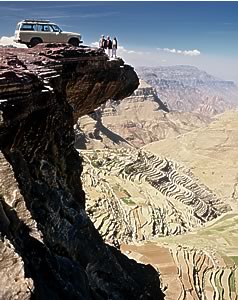"The Full On Experience of Yemen"
Newspaper story & fine art photographs by Brad Carlile
Freeport Journal Standard, 20-May-2001 p. C6.

In the early hours of Friday October 13th, CNN.com reported that a bomb exploded on the USS Cole in Aden Yemen killing US sailors. They added " US officials call Yemen a safe haven for terrorists". Other articles use the term "medieval" to describe modern Yemen.
In our busy world, we quickly let our minds paint in all of the rest of the details of this country and its people. Time to be thankful for where we are and move on. But sometimes we should explore deeper. In those same early hours of Friday October 13th, I finish packing my backpack for a five week trip to Morocco, Jordan, and Yemen.
When I started planning my trip several months earlier, friends asked about Yemen. Where do I find it on a map? They learned that this country -- about four times the size of Illinois, is located to the southern tip of the Saudi peninsula. It is one of the oldest inhabited areas on the earth.
As I flew the Atlantic, I knew to expect to interesting contrasts in Yemen -- a country rich in history, culture, and scenery.
Yemeni History

Historically, Yemen has come into significance at times only to fade into general obscurity. In the 10th century BC, the Queen of Sheba ruled her civilization in what is now Yemen. Latter in biblical times, Frankincense and Myrrh, the most valuable commodity of that time, originated in Yemen. Also then most goods from India and China passed through Yemen on their way to the Mediterranean. Then three hundred years ago, Yemen had the world's monopoly on coffee which was produced from the prized Arabica coffee bean. Much of the coffee was shipped from the old port town of Al-Makha -- where we now get the name "Mocca". Later this bean was carried to South America and Indonesia. Since then little has been heard about Yemen in the western world.
Religiously, Yemen is a Moslem nation. Five times a day the call to prayer is blasted from speakers mounted on minarets throughout every city and town. In strict Moslem tradition to preserve modesty, the women are dressed head to toe in black with only a tiny slit for their eyes. Very stylish shoes are the only thing that hint of non-traditionalism. The shoes are as modern as any seen on the streets of European capitals. Inside the house when around family and friends, the outer robes come off to reveal very modern outfits.
Geographically Yemen is very diverse. The 7000' mountains of the western half provide a perfect climate for growing some of the finest coffee in the world. Whereas, the northern desert that boarders Saudia Arabia is a barren flat dry hot rocky desert. On the southern coast the fine white sand beaches give way to the clear blue waters of the gulf of Aden.
Sana'a Yemen
My trip started in Sana'a, the capital city, which is situated in a mountainous basin at about 7000 feet above sea level. At this elevation temperatures are moderate.
Most of the million residents live in the modern part of Sana'a. However the true charm of the city is in old city with its amazingly ornate 6- to 8-story tower houses.
Time moves at a slower pace even in capital of Yemen. Largely this is due to the importance of human relationships in every aspect of life. Time is always made for smiles, conversation, and news about families. At social gatherings the love of verbal banter & jokes is clear.
I was told that as a solo American traveling on local transport at this time I might run into bureaucratic hassles. To avoid hassles and not to waste any time, I hired a car & driver for less than renting a compact car in the US.
Sharaf, My Fantastic Driver in Yemen
My driver's name is Sharaf. He is a very nice man who enjoys life, loves his family, and knows all of the best places to go. I knew more Arabic than he knew English, which really meant we had fewer than 400 words between us, nevertheless we each learned many things from the otherand become friends.
As an attempt at being culturally sensitive-- beyond learning a bit of the language -- I grew the first beard of my life. Once in Yemen I wore a jacket and a kaffiyeh, or checkered head cloth, when traveling the country-side. Sharaf encouraged me to do this. These tiny attempts to fit in a bit were appreciated by many I met.
Yemini Western Highlands

As we drove around the towns nestled in the craggy peaks of the western highlands, we would listened to tapes of Yemeni songs. Vistas in this mountainous region are astounding and dramatic. Many mountain sides have hundreds of levels of terracing which allows all of the land to be used in this fertile region.
In addition, houses are built on the edges of cliffs and ridges to preserve all of the arable land. Throughout Yemen, great pride is taken in the old tradition of beautiful architecture. The outside of these brick and rock houses are covered intricate geometric white plaster designs that outline the windows and ring the top of the buildings. We would often give locals rides between villages, a nice thing to do on these steep mountain roads. Most main roads are some of the best I've seen anywhere in my third world travels. However to get to some more interesting spots we would travel stretches that would require years of improvement it even be considered a road hazard and many more years to be considered a road.
Yemini Food: Salta, coffee, and other delicious food

Lunch is the big meal of the day. The food was very different than the humus and shish kabobs of middle eastern cuisine. Salta is the national dish. It is a spiced fenugreek tomato potato stew containing lamb or chicken. It is eaten with a flavorful sorghum flat bread.
Typical lunch would include a lentil-lemon soup, cooked vegetables, a kind of fried rice, hot peppers, Salta,and grilled chicken. One left the table well fed. On special occasions the wonderful "Bint al Sahn" was served as dessert. It is a sweet bread that is dipped into honey and clarified butter.
Coffee is so highly regarded that it is reserved for use at home. But when one can get it in a restaurant, it is amazing -- even for a non coffee drinker.
After lunch, most men and woman spend several hours socially chewing Qat (pronounced khat). Qat is a shrub whose leaves act as are a mild stimulant that boosts one's mood when chewed. Qat is legal in Yemen and it is a national obsession. Unofficial estimates are that qat accounts for one-third of the domestic economy.
After traveling for several days we returned to Sana'a to have tea with Sharaf's family, where I met and played with his twin granddaughters. Early the next morning we would start a week-long trip that would take us to the southern coast at Bir Ali and Al-Mukalla, then to Wadi Hadramawt, and then into the eastern desert. We would then travel across the desert on the boarder with Saudia Arabia to Marib, which was home to the Queen of Sheba.
In order to travel outside the western highlands, one needs to file a travel itinerary with the government and carry lots of copies to give out at the police checkpoints. Given that Yemen wants safe tourists, there are a lot of police checkpoints. Often policeman will often ride in the vehicle between checkpoints.
AK-47s & Knives
I was never sure how much of this was due to safety and how much was due to the supplemental income generated by tips from tourists. However, this is also a land with 60 million guns and only 15 million people. All men wear a ceremonial knife called a Jambiya. In addition, most men have an AK-47 slung over their shoulder - more as part of a dress code than a sign trouble being around the corner.
After crossing the central desert highlands, we go to a fertile valley called Wadi Hadramawt. As Sharaf rounded a corner, the five hundred tightly-clustered skyscrapers of the town of Shibam jutted out from the flat valley floor. Rightly so, Shibam is often called "The Manhattan of the Desert".
Many of the tower houses are 7 stories tall and rise over 100 feet tall. Amazingly they are built from adobe, then the facades are covered in patterns of brown and light-colored lime plaster.
Wadi Hadramawt
After seeing many of towns in Wadi Hadramawt we headed back across the desert, somewhat near the Saudi boarder, to Marib the ancient center of the Sheba Civilization. This civilization had amazing accomplishments including a dam that was 2,200 feet long and was 50 feet high at its midpoint that lasted for over 1,300 years. Remnants of the dam and two temples are in the process of being excavated.
Queen of Sheba, five Yemenis, four AK-47s, three bags of Qat, a battery & me
I named the return trip from the Sheba temples "Queen of Sheba, five Yemenis, four AK-47s, three bags of Qat, a battery and me." It describes the moment after we picked up a policeman escort, a man carrying a car battery, and a couple of Yemenis headed to an eye clinic. With of course, three of them were chewing Qat and all four in the back seat carried AK-47s.
Yemen was my favorite country during my five weeks of travel -- it was also more intense. Travel was much easier in Morocco and Jordan, countries that are popular with tourists.
Yemen is a beautiful country. It is a land of friendly happy people who share great hospitality to everyone, especially strangers. They have a special enjoyment of family, music, great food, and laughter. These are things I will always fondly remember. It is indeed a place so extraordinary, so separate from the rest of the world that it seems unreal.